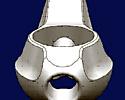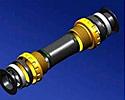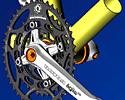
Recently on Cyclingnews.com |
Tech News – August 4, 2006Edited by John Stevenson, James Huang and John Kenny Got tech? Send press releases, news, and tech questions to the Cyclingnews tech desk.
Rotor's elliptical Q-Rings now available as a complete cranksetBy James Huang The company that brought you the unique Rotor crankset and the elliptical Q-Rings now brings a conventional crankset to the table. The new Rotor Ágilis incorporates some unique features, and for the first time, allows consumers to purchase the company's Q-Rings as part of a complete package. As such, Q-Ring purchasers will not have to resort to retrofitting another manufacturer's crankset which often results in the removal of a perfectly good set of round rings right from the get-go. The Ágilis crankarms start out as extruded aluminum bars which are then lathe-turned, CNC-machined, and centre-bored in a process dubbed 'Hollowminium'. This effectively yields hollow arms that retain the stiffness of the outer shape, but removes the extra material from the center that would otherwise just add mostly useless mass. Not surprisingly, most high-end crankarms are now filled with nothing but air for exactly that reason. The Ágilis crankset will be a 'semi-integrated' crankset, with a pseudo-permanently fixed aluminum spindle attached to the non-drive side with a double-threaded bolt. This unique style of attachment will allow for slight adjustments in spindle length to accommodate variations in bottom bracket shell width. The driveside arm will attach via a seven-sided taper. In keeping with current industry trends, an external-style bottom bracket will be used, but with a novel twist. The cartridge bearings in Rotor's Self Aligning Bottom Bracket (SABB) are housed in spherical supports that automatically keep the bearings parallel to each other, resulting in reduced friction and increased bearing life. This shouldn't be a replacement for proper facing and thread-cutting, but improved bearing alignment can hardly be faulted. Distinct road and mountain bike versions will be available, either with or without Q-Rings. Road chainring spiders will be offered in both 130mm and 135mm BCD standards, and all mountain cranksets will bear the current 104/64mm 4-arm pattern. Target weights for the complete Ágilis, including Q-Rings, are 720g and 780g for the road and mountain versions, respectively. Rotor's new crankset has yet to hit production and suggested retail pricing is yet to be announced, but production is slated for later this fall. For more information see www.rotorbike.com
SRAM urges rethinking of proper chain sizingBy James Huang Sizing a chain used to be a rather straightforward affair, with any one of the several accepted techniques yielding chain lengths that are typically within a link of each other. In general, if the chain could accommodate the large chainring-large cog combination without sagging in the other extreme, you were good to go. The prevalence of full-suspension mountain bikes, however, has complicated the matter as the effective chainstay length can change dramatically as the suspension moves through its travel. Usually, this length increases during compression, and the change can be particularly pronounced on certain suspension designs and/or longer travel rigs. Therefore, if chains are sized using the old standard methods and the suspension is compressed when in the big-big combo, the results can be rather "unpleasant", and often costly. In response to what has clearly been a marked increase in "JRA rear derailleur explosion" (industry jargon for 'Just Riding Along' ) complaints, SRAM has released the following "Chain Sizing Made Easy" guidelines, which are applicable regardless of chain make or model: 1. Wrap a full-length chain around the largest chain ring and largest
cog combination, bypassing the derailleurs. Keep in mind that this method may result in insufficient chain tension in some cogs while in the inner chainring, but you probably already know better than to run in those cross-gear combinations anyway. Besides, the elimination of a few mostly-unusable gears is a much more appealing alternative to having your entire rear end shatter in spectacular fashion. For more information see www.sram.com
Jagwire goes pink for breast cancerCable maker Jagwire is introducing versions of its Ripcord brake and gear cable kits with pink housing to raise money for breast cancer research. The housing will be available in September and for each kit sold, Jagwire and its distributors will contribute a portion of the proceeds to benefit breast cancer research. "Jagwire has a tradition of supporting charity and advocacy efforts," said Jason Grantz, director of aftermarket products for Jagwire. "The pink housing promotion is an opportunity to help advance research that can save lives." Jagwire will also make a limited number of kits available to dealers during the Interbike and Eurobike trade shows. At the shows, dealers will be able to obtain one kit per $25.00 contribution; Jagwire will donate all the money to various breast cancer research organizations. For more information see www.PinkCables.com.
Fixies outlawed?By John Stevenson There's been a bit of hoo-ha in various bike forums around the net in the last few days about a case in Portland, Oregon where a rider was fined for not having a separate brake on her fixed-gear bike. According to bikeportland.org, bike messenger Ayla Holland was ticketed on June 1 and charged with violating Oregon Revised Statute (ORS) 815.280(2)(a) which states: A bicycle must be equipped with a brake that enables the operator to make the braked wheels skid on dry, level, clean pavement. strong enough to skid tire. Ms Holland's lawyer Mark Ginsberg attempted to argue that a fixie's transmission constituted a brake. The judge was having none of it, and in his decision said: "The brake must be a device separate from the musculature of the rider. Take me for instance. I don't have leg muscles as strong as a messenger… how would I stop safely?" This has led to some rather alarmist talk about the future of fixies. "Will the cops now feel emboldened to go out and ticket everyone on a fixed-gear? Are fixed-gears now essentially illegal? Are fixed-gears truly a public safety hazard?" asks Jonathan Maus in bikeportland.org. Well, no. The issue here is a badly-written piece of legislation being interpreted by a judge so that it achieves its aims, rather than what the absolute letter of the law says. A fixed-gear bike with no brakes cannot stop in as short a space as one with a front brake, because only the rear wheel is providing the braking force. As a vehicle on the road, it's therefore clearly less safe. This is a matter of simple physics. In the third edition of Bicycling Science, David Gordon Wilson demonstrates that the maximum deceleration of a crouched rider on a standard bike (that is, not a recumbent) on a dry road is 0.56g. Try to brake any harder than that and you go over the handlebars, which is the limit condition, as the limit from tyre adhesion of vehicles that don't pitch over (tandems, recumbents and cars) is about 0.8g. If you brake with only the rear wheel, according to Wilson, the limit is 0.256g, because braking effectively shifts your weight forward, reducing the load on the rear wheel to the point that it skids at that deceleration. Once a tyre is skidding, its braking effectiveness is reduced because you no longer have sticky solid rubber in contact with the road, but a lubricating layer of molten rubber. (Which incidentally demonstrates that the Oregon legislation was written by someone with no clue at all about bikes.) Therefore, however good a fixie rider is, stopping distance is roughly doubled without a front brake. In practice, it's probably more than that. In some jurisdictions, better-written laws make this issue moot. In the UK, for example, the law requires a bike to have two independent braking systems. I used to ride a fixie in the winter in the UK, and I knew quite a few fixie riders who dispensed with a rear brake on the grounds that the transmission was a braking system, but I never met anyone daft enough to have just a rear brake. This judge has clearly decided to ignore the letter of the law in favour of enforcing its obvious intent, that bikes have at least one maximally effective brake. That's the sort of thing judges are handy for: turning idiotically badly-written legislation into rules that make sense in the real world. All that fixie riders have to do to conform is slap on a front brake; hardly rocket surgery, and a long way from fixies being suddenly illegal. And to fixie riders who are about to reach for the email to defend riding brakeless fixies, I refer you to Cmdr Montgomery Scott: "You canna change the laws of physics!"
|






